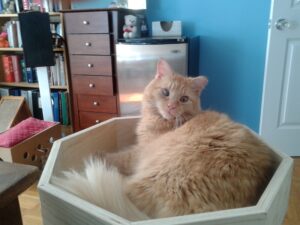Barks Blog
Spray Bottles Are for Houseplants, Not Cats
By Beth Adelman, MS

It’s piece of bad advice that just won’t die: When your cat is misbehaving, squirt her with some water. Even some veterinarians still say it.
What’s wrong with the spray bottle? Well, for starters, it doesn’t work. Yes, when you squirt your cat, she is very likely to stop what she’s doing and run away. But if you squirt her, say, when she jumps on your dinner table, what have you accomplished? You may have taught her to run away at the sight of the bottle; you may have taught her that when you are around and the spray bottle is nearby, she can’t jump on your dinner table—although she can get up there when you’re not around; you may have taught her that when the bottle appears, a fun chase game begins. You have not taught her to stay off your dinner table.
There’s always a big problem with saying “no” to an animal—with a spray bottle, with your voice, or any other way. The problem is that it doesn’t convey any useful information. When I see my cat sitting on the dinner table and say “no,” does that mean don’t sit, don’t look at me, don’t be on the table? Which of the many things he is doing at that moment am I referring to? He has no way to know precisely what I mean. Maybe “no” means don’t meow, don’t move, don’t breathe. In the end, it doesn’t mean anything.
So now what? In that moment when your cat is doing something you wish she wasn’t, ask yourself, “What would I like her to do instead?” When my cat is on the table, I want him to get off. So I tell him that: “off” (I taught him a verbal cue and a hand signal). When he gets off, I praise him for doing exactly what I asked. So now I have given him very clear information, and presented him with an opportunity to earn a reward (my praise, accompanied by a treat or a kiss). Of course he complies!
That solves the problem in the moment, but how do I teach him to stay off the table all the time—even when I’m not around to remind him? Time to ask yourself another question: “What function does that behavior serve?” In other words, why does my cat go on the table?
While the answer may be different for your cat in your home, in my home he only goes up there when someone is sitting at the table. It’s not about the food; he’ll get up on the table if I’m reading a magazine. He just likes to be up high with his humans. So I put a small shelf on the wall next to the table, and placed a little towel on it. When he gets on the table, I tell him “off” and pat the shelf. When he jumps to it, “Good boy!” and then he gets lots of attention and petting.
These days, he almost always hangs out on his shelf when we’re at the table, and gets pets and kisses when he does. He sometime sleeps on his shelf. I know he doesn’t hang out on the table when I’m not around because he’s a white cat and it’s a dark table; I’d see the hair.
So problem-solving does not come out of the squirt end of a spray bottle. It really just comes down to asking yourself a couple of simple questions:
What’s the function of the behavior?
How can you satisfy that function in a way that works for you?
What would you like your cat to do instead?
About the Author
Beth Adelman, MS, is a Cat Behavior Consultant in Brooklyn, New York. She currently is a regular speaker on cat behavior at New York’s Meow Parlour and sits on PPG’s Cat Committee.

